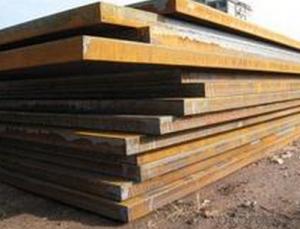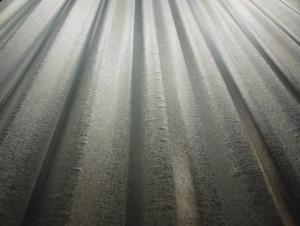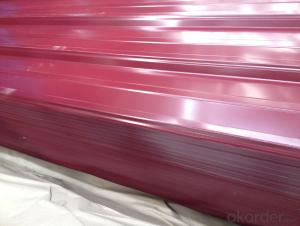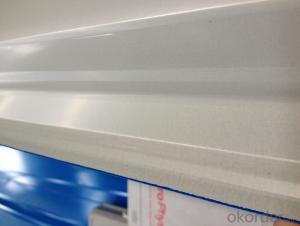Hot Rolled Carbon Steel Sheet SS300 CNBM
- Loading Port:
- Qingdao
- Payment Terms:
- TT OR LC
- Min Order Qty:
- 10 pc
- Supply Capability:
- 30 pc/month
OKorder Service Pledge
Quality Product, Order Online Tracking, Timely Delivery
OKorder Financial Service
Credit Rating, Credit Services, Credit Purchasing
You Might Also Like
Quick Details
| Standard: | AISI, ASTM, DIN, GB, JIS | Grade: | A572,A573,A633,A678,A709,A710,G3101,G3136,etc | Thickness: | 1mm-200mm |
| Brand Name: | SHOU GANG GROUP, AN STEEL | Model Number: | Q235 | ||
| Type: | Steel Plate | Technique: | Hot Rolled | Surface Treatment: | Coated |
| Application: | widely | Special Use: | High-strength Steel Plate | Width: | 1000mm-3000mm |
| Length: | 1000mm-12000mm | Price Term: | FOB CIF CFR |
Packaging & Delivery
| Packaging Details: | standard seaworthy export packing or as the request of customers |
| Delivery Detail: | 10 days after deposit or according to customers' quantity |
Specifications
hot rolled carbon steel sheet
1.Thickness:1mm-200mm
2.Length:1000mm-12000mm
3.Width:1000mm-2000mm
hot rolled carbon steel sheet
| Product | HR steel plate prices carbon steel plate prices per kg |
| MOQ | 25 ton |
| Thickness | 1mm-200mm |
| Width | 1000mm-3000mm |
| Length | 1000mm-12000mm |
| Application | widely |
| Standard | AISI,ASTM,BS,DIN,JIS,GB,etc |
| Grade | A572,A573,A633,A678,A709,A710,G3101,G3136,etc |
| Tpye | Steel plate |
| Surfacing | Coated |
| Productive Technology | Hot Rolled & Cold Rolled |
| Port | |
| Payment Terms | L/C,T/T,Western Union,MoneyGram |
| Product Ability | 5000 tons per month |
| Delivery | 10 days after deposit or according to customers' quantity |
| Packing | standard seaworthy export packing or as the request of customers |
- Q: What kind of material does ordinary steel plate refer to in steel market?
- This is not difficult to understand. The chemical composition of ordinary steel is very simple. It is only made of carbon and iron. But the alloy steel plate is according to the different design request and the construction request to deploy its chemical composition, the different design request will affect the alloy steel plate in the choice alloy element choice.
- Q: Are the steel sheets available in different grades?
- Yes, steel sheets are available in different grades. Steel is classified into various grades based on its composition, strength, and other properties. These grades include carbon steel, stainless steel, alloy steel, and tool steel, among others. Each grade has its own unique characteristics and is suitable for different applications. The choice of grade depends on factors such as the required strength, corrosion resistance, and cost-effectiveness for the specific application. Therefore, when purchasing steel sheets, it is important to consider the grade that best suits the intended use.
- Q: Are steel sheets suitable for laser cutting or engraving?
- Yes, steel sheets are suitable for laser cutting and engraving. The high intensity laser can easily cut through steel sheets, while engraving techniques can be used to create intricate designs or markings on the surface of the steel.
- Q: What is the process of laminating steel sheets?
- The process of laminating steel sheets involves several steps to create a composite material that is stronger and more durable than traditional steel. First, the steel sheets are cleaned and prepped to remove any impurities or contaminants. This is important to ensure a strong bond between the layers and prevent any defects in the final product. Next, a layer of adhesive is applied to one or both sides of the steel sheets. The adhesive can be a thermosetting resin or a thermoplastic material, depending on the desired properties of the laminated steel. After the adhesive is applied, the steel sheets are stacked together, with the adhesive layer(s) in between. The sheets are then subjected to high temperature and pressure to initiate the bonding process. This can be done using a hydraulic press or a hot rolling mill. The combination of heat and pressure causes the adhesive to melt and flow, creating a strong chemical bond between the steel sheets. The high pressure ensures that the adhesive is evenly distributed and fills any gaps or irregularities between the sheets. Once the bonding process is complete, the laminated steel sheets are cooled and trimmed to the desired size and shape. They can then be further processed, such as by cutting, bending, or welding, to meet specific application requirements. Overall, the process of laminating steel sheets involves cleaning and prepping the sheets, applying adhesive, stacking the sheets, subjecting them to high temperature and pressure, cooling, and finalizing the shape. This process results in a composite material with improved strength, corrosion resistance, and other desirable properties compared to traditional steel.
- Q: What are the safety precautions to consider when handling steel sheets?
- When handling steel sheets, there are several safety precautions to consider. Firstly, it is important to wear appropriate personal protective equipment (PPE) such as gloves, safety glasses, and steel-toed boots to protect against cuts, burns, and impact injuries. Secondly, ensure that the work area is well-lit and free from clutter to prevent accidents and tripping hazards. Additionally, use proper lifting techniques and equipment, such as cranes or forklifts, to avoid strains and back injuries. It is also crucial to be mindful of the weight and size of the steel sheets being handled, as well as their sharp edges, and take necessary precautions to prevent them from falling or causing injuries. Finally, employees should receive proper training on the safe handling and storage of steel sheets to minimize risks and ensure a safe working environment.
- Q: What are the different methods of protecting steel sheets from graffiti?
- There are several methods for protecting steel sheets from graffiti, including applying anti-graffiti coatings, using sacrificial graffiti films, installing anti-graffiti barriers such as fences or screens, and implementing community engagement programs to discourage graffiti vandalism.
- Q: What is the minimum order quantity for steel sheets?
- The minimum order quantity for steel sheets can vary depending on the supplier and specific requirements, but it is typically measured in metric tons.
- Q: What is the average weight of a steel sheet?
- The average weight of a steel sheet can vary depending on its dimensions, thickness, and type of steel used. However, as a general guideline, a common steel sheet with a thickness of 1mm and a size of 1m by 1m would typically weigh around 7.85 kilograms. It's important to note that this is just an approximation, and the actual weight can vary based on the specific characteristics of the steel sheet. To get an accurate weight, it is best to consult the manufacturer or refer to the steel sheet's specifications.
- Q: Are steel sheets suitable for corrosive environments?
- No, steel sheets are not suitable for corrosive environments as they are prone to rust and degradation when exposed to moisture and certain chemicals.
- Q: What are the different coating options for steel sheets (powder coating, paint, etc.)?
- There are several different coating options available for steel sheets, each offering unique benefits and characteristics. Some of the most common coating options include: 1. Powder coating: Powder coating involves applying a dry powder coating material onto the steel sheet. This coating is then cured under heat to form a protective layer. Powder coating provides excellent durability, corrosion resistance, and aesthetic appeal. It is also environmentally friendly, as it does not contain solvents or VOCs. 2. Paint: Paint is one of the most traditional coating options for steel sheets. It involves applying liquid paint onto the surface, which then dries and forms a protective layer. Paint coatings offer a wide range of colors and finishes, making them suitable for various applications. However, they may require periodic maintenance and can be susceptible to chipping and peeling. 3. Galvanizing: Galvanizing is a popular coating method for steel sheets, especially in industries where corrosion resistance is crucial. It involves applying a layer of zinc onto the steel surface through a hot-dip process. This creates a protective barrier that prevents corrosion and rusting. Galvanized coatings are highly durable and long-lasting. 4. Epoxy coatings: Epoxy coatings are known for their excellent chemical resistance and adhesion properties. They provide a tough and durable finish that protects steel sheets from corrosion, chemicals, and abrasion. Epoxy coatings are commonly used in industrial settings where harsh conditions are prevalent. 5. Chromate conversion coatings: Chromate conversion coatings, also known as chemical conversion coatings, are applied to steel sheets to enhance their corrosion resistance and improve paint adhesion. These coatings are typically thin and translucent, providing a clear or slightly yellowish appearance. Chromate conversion coatings are commonly used as a pre-treatment before painting or powder coating. 6. Ceramic coatings: Ceramic coatings offer exceptional heat resistance and durability. They are often utilized in high-temperature applications, such as exhaust systems or industrial ovens. Ceramic coatings can withstand extreme temperatures, corrosion, and abrasion, making them ideal for demanding environments. These are just a few of the coating options available for steel sheets. The choice of coating will depend on factors such as the intended application, desired appearance, environmental conditions, and budget. Consulting with a coating specialist or manufacturer can help determine the most suitable coating option for specific requirements.
Send your message to us
Hot Rolled Carbon Steel Sheet SS300 CNBM
- Loading Port:
- Qingdao
- Payment Terms:
- TT OR LC
- Min Order Qty:
- 10 pc
- Supply Capability:
- 30 pc/month
OKorder Service Pledge
Quality Product, Order Online Tracking, Timely Delivery
OKorder Financial Service
Credit Rating, Credit Services, Credit Purchasing
Similar products
Hot products
Hot Searches
Related keywords


























